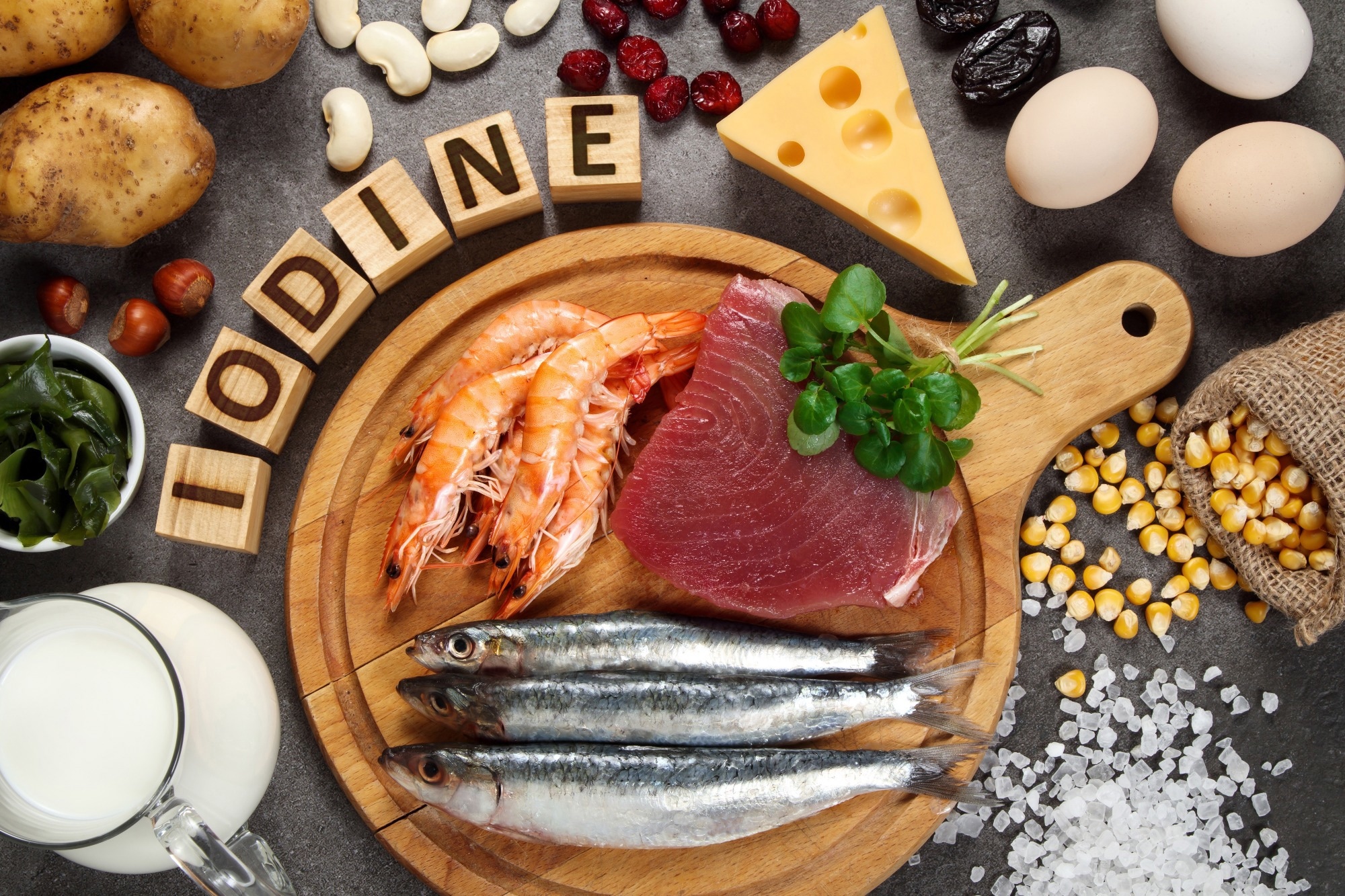In a recent study published in Frontiers in Nutrition, researchers reviewed recent data on the metabolic implications of iodine consumption and elucidated the underlying mechanisms.
 Study: The correlation between iodine and metabolism: a review. Image Credit: Evan Lorne/Shutterstock.com
Study: The correlation between iodine and metabolism: a review. Image Credit: Evan Lorne/Shutterstock.com
Background
Iodine is an essential nutrient that aids in producing thyroid hormones and is associated with metabolic illnesses such as diabetes, obesity, dyslipidemia, and hypertension.
However, the processes underlying these relationships are unknown. Iodine exerts immunomodulator, antioxidant, and differentiator effects in several tissues and organs, and alters the levels of thyroxine (T4) and tri-iodothyronine (T3), the primary regulators of energy metabolism.
Metabolic syndrome (MetS), which includes hypertension, abdominal obesity, hyperlipidemia, and hyperglycemia, is common globally and can lead to cardiovascular disease, malignancies, and death. Oxidative stress, chronic inflammatory diseases, and dietary changes are all risk factors for MetS.
The nutritional status of iodine may partly explain the incidence of metabolic syndrome. Further study on the relationship between iodine and metabolism will contribute to a better understanding of its role and promote an adequate and reliable iodine feeding standard.
About the study
In the present study, researchers explored the impact of iodine levels on metabolic health.
Research on the effects of iodine on metabolism
The recommended dietary allowance (RDA) of iodine ranges between 150 and 299 μg/day, with a moderately increased consumption potentially lowering the risk of prostate and breast cancer.
Cross-sectional research indicates a U-shaped association between urinary iodine concentration (UIC) and metabolic syndrome prevalence, with a low point of 300 to 499 μg/L.
In Korean postmenopausal women, consuming seaweeds and iodine showed inverse correlations with MetS incidence; however, excess seaweed intake demonstrated adverse effects among male MetS patients with TT and TG genotypes of the lipoprotein lipase gene (LPL). However, a study of school-aged children discovered associations between high UIC and MetS.
Research in China indicated central adiposity decreased when UIC levels reached ≥300 μg/L. A randomized clinical trial found that individuals who received iodine-reduced kelp tablets had a significantly lower body fat percentage.
A 28-day placebo-controlled trial discovered that fucoxanthin seaweed supplementation reduced waist circumference, fat mass, visceral fat, weight, and BMI among obese residents of Japan. However, among reproductive-age Colombian women, mUIC was shown to be positively linked with obesity.
The TIDE study demonstrated a U-shape curve for the relationship between urinary iodine concentration and diabetes prevalence, with higher UIC levels increasing the likelihood of acquiring diabetes mellitus type 2 (T2DM). Patients with diabetes mellitus have lower UIC levels than healthy individuals.
Increased iodine content in the placenta lowers gestational diabetes in pregnant women. The study also discovered a U-shaped curve in the correlation between UIC and hypertension prevalence, with individuals in iodine-excess (IE) and iodine-sufficient (IS) locations having higher blood pressure readings. Iodine deficiency is a risk factor for preeclampsia and pregnancy-related hypertension.
Research has demonstrated an inverse relationship between UIC, hyperuricemia, and gout prevalence. Longitudinal data revealed higher death rates among patients with ID (UIC <100 μg/L).
Iodine consumption can raise blood cholesterol levels in hens and cause hepatic steatosis in BaLB/c mice. In mice, higher iodine consumption enhanced lipid metabolism without affecting thyroid hormone levels or body weight.
Mechanisms underlying the metabolic effects of iodine
Iodine exerts antioxidative, antimicrobial, immunomodulatory, and molecular regulatory effects. Iodine alters the proportion of pathogenic and beneficial bacteria to restore the gut microbiome and reduce insulin resistance, obesity, and metabolic syndrome parameters.
Iodine also reduces inflammation by lowering oxidative and endoplasmic reticulum stress caused by free radicals such as reactive oxygen species (ROS).
Iodine acts on the Kelch-like ECH-associated protein 1-NF-E2-related factor 2 (KEAP1-NRF2) pathway to enhance the activities of antioxidant enzymes such as superoxide dismutase (SOD), catalase (Cat), and glutathione peroxidase (GSH-Px).
In addition, iodine alters inducible nitric oxide synthase (iNOS) and cyclooxygenase-2 (COX2) levels, regulating mitogen-activated protein kinase (MAPK) and nuclear factor kappa B (NF-κB) pathways to reduce chronic inflammation and improve metabolic health.
The mineral acts on type 2 deiodinase (D2) receptors that convert T4 to biologically active T3 to improve weight management and adaptive thermogenesis.
Iodine also interacts with peroxisome proliferator-activated receptor-γ (PPARγ) receptors to enhance adipocyte differentiation, fatty acid uptake, and glucose metabolism by improving insulin sensitivity.
Conclusions
Overall, the review findings indicate that iodine impacts obesity, lipid metabolism, and glucose metabolism. Iodine's antioxidant, immunomodulatory, gut-restoring, and antimicrobial effects explain the mineral's effects.
Iodine regulates the oxidative state related to variations in insulin sensitivity or metabolism. However, iodine shortages and persistent iodine excesses may increase the risk of thyroid diseases.
Thus, it is critical to maintain iodine levels in an appropriate range at a population level. Future prospective studies and mechanism research must develop an evidence-backed and safe iodine nutrition standard.